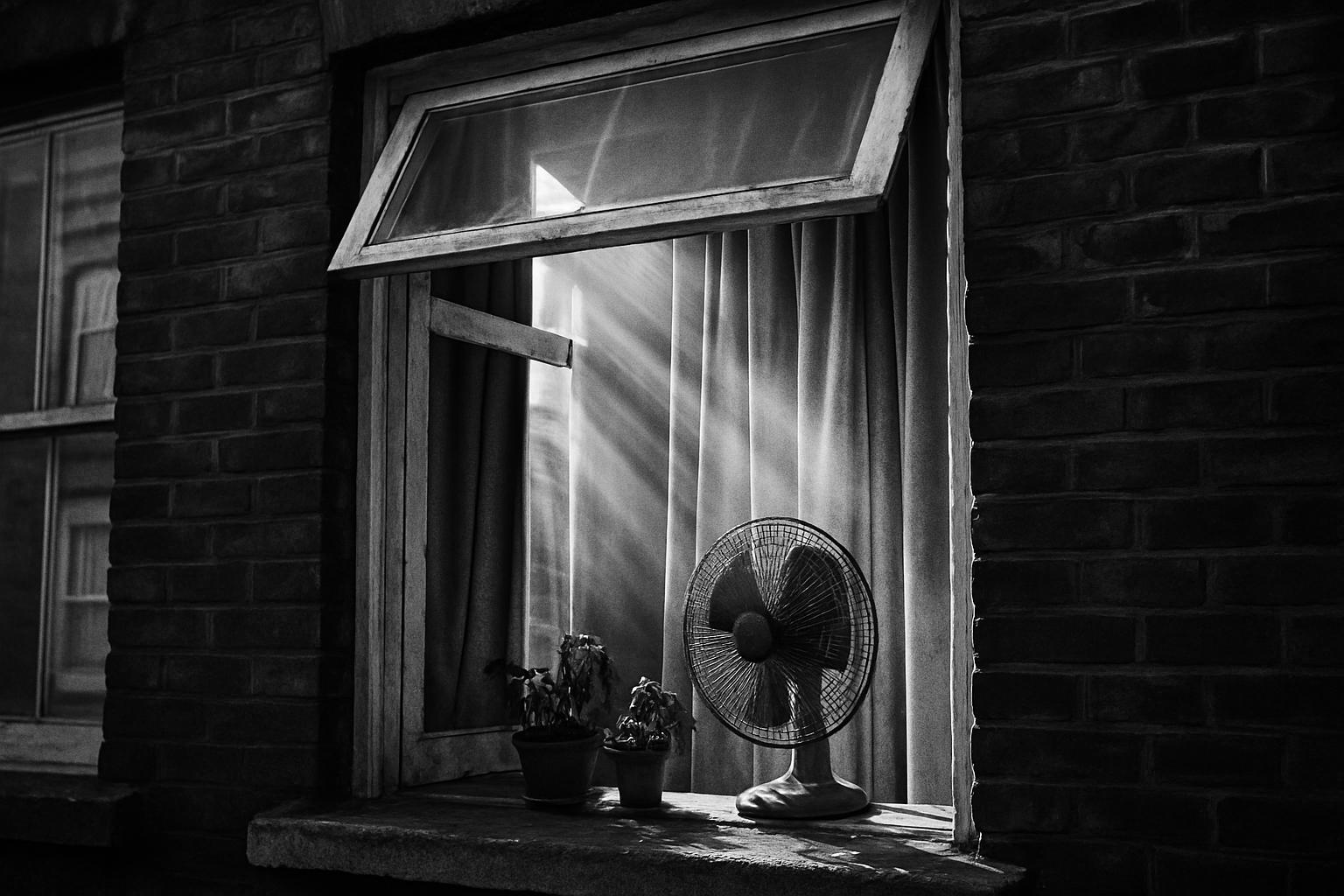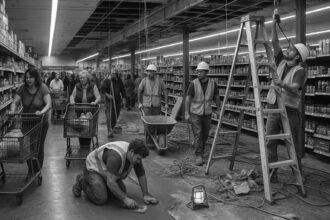New Met Office modelling makes another 40°C UK day as likely as not within the next 12 years, yet adaptation across homes, water and energy networks is patchy. Experts and the Climate Change Committee urge rapid, funded retrofit, stronger standards for any mechanical cooling and neighbourhood greening to avoid mounting health, infrastructure and emissions risks.
Wondering what future British summers will be like as the climate crisis unfolds? Put away visions of sipping cool drinks on a Barcelona-style balcony. Instead, picture increasingly stuffy, overheated homes that make sleep difficult, prolonged hot spells that strain water supplies and electricity networks, and mounting health warnings for the very old and very young. “What we are facing is climate brutality. That is the reality of the hotter weather coming down the track,” Simon McWhirter, chief executive of the UK Green Building Council, warned in an interview with The Guardian, encapsulating the urgency behind the warnings from scientists and industry alike.
The warning is backed by climate science. The Met Office says the verified UK peak of 40.3°C in July 2022 is no one-off: large-ensemble modelling now estimates roughly a 50:50 chance of another 40°C day within the next 12 years and anticipates longer, hotter heatwaves. That rising probability of extreme summer temperatures underpins calls for rapid preparation across public health, infrastructure and town planning.
Government advisers are blunt about the gap between risk and readiness. The Climate Change Committee’s 2025 progress report to Parliament found that preparations remain inadequate across multiple sectors: water, transport, energy and communications are all exposed to escalating risks from floods, droughts and heat, and the committee warned of rising heat-related mortality unless adaptation is accelerated and better funded.
Many of the practical fixes for keeping homes habitable are well known but unevenly implemented. Architects and campaigners point to simple, passive measures — good cross-ventilation, appropriately sited and designed windows, external shutters, reflective roof and façade finishes, and water‑efficient fittings that can help households manage summer droughts — all of which are emphasised in industry guidance and resilience roadmaps. Official building guidance for England, Approved Document O, which supports Part O of the Building Regulations, sets out compliance routes that prioritise such passive approaches, including dynamic thermal modelling, shading and ventilation strategies, to reduce reliance on mechanical cooling.
Cooling the urban fabric also requires thinking beyond individual houses. The UK Green Building Council has pushed a neighbourhood-level approach in its Climate Resilience Roadmap, including nature‑based cooling and canopy targets. The so-called 3:30:300 rule — being able to see three trees from your dwelling, achieving 30 per cent tree canopy in a neighbourhood, and living within 300 metres of a high‑quality green space — is increasingly cited by planners. A recent peer‑reviewed evaluation of that guideline finds empirical links between canopy cover, proximity to greenspace and health, while noting implementation and equity challenges that must be addressed by measurable targets and monitoring.
Policy settings complicate the picture. New rules intended to overhaul how homes are built — the long‑promised Future Homes Standard — have been delayed for years and, critics say, still concentrate mainly on winter energy conservation rather than summer overheating. Industry figures emphasise that better insulation in new builds makes them more comfortable year‑round: Steve Turner, executive director of the Home Builders Federation, told The Guardian that modern, well‑insulated new homes “stay both warmer in winter and cooler in summer” and are cheaper to run than older stock. But insulation alone will not solve the overheating risk unless design and neighbourhood measures are consistently applied.
Part O of the Building Regulations, which seeks to limit overheating in new residential buildings, came into force in June 2022 and applies only to new homes. The Approved Document that supports it foregrounds passive mitigation and documentation of design choices rather than defaulting to mechanical cooling. That leaves the vast majority of existing dwellings — the homes where most people live — outside regulatory protection unless retrofits or change‑of‑use rules are extended.
A politically fraught debate has opened over mechanical cooling. Ministers are reported to be considering subsidising air conditioning for the first time through an expanded boiler upgrade scheme; the government has also suggested allowing “air‑to‑air” heat pumps — appliances that can both heat and cool by exchanging heat with outside air — to be eligible for support in properties where conventional heat pumps are hard to install. The government told The Guardian it is exploring these options alongside further modelling and research. Campaigners and some industry bodies back measures that reduce summertime suffering, but others point out trade‑offs: air‑conditioning is energy‑intensive, and cheaper, less efficient systems risk increasing electricity demand and emissions if not tightly regulated.
That energy trade‑off is not hypothetical. International analysis warns that space cooling is the fastest‑growing energy use in buildings globally and, without strong efficiency standards and integrated planning, demand could more than treble by 2050 — a surge that would strain grids and could overwhelm the emission reductions from renewable power deployment. Those findings add weight to calls for favouring high‑efficiency cooling technologies where mechanical systems are unavoidable and for prioritising passive and nature‑based approaches wherever possible.
Even the most ambitious new‑build programme would take decades to alter the composition of the nation’s housing stock. The government’s target for new homes, even if met, would leave existing buildings to carry much of the adaptation burden. The Climate Change Committee and resilience campaigners therefore urge fast, properly funded retrofit programmes, clearer cross‑government objectives, strengthened monitoring and enforcement — including for the private rented sector — and the embedding of adaptation into every relevant policy area to reduce mounting social and economic costs.
The lesson running through scientific reports, industry roadmaps and statutory advice is consistent: a mix of design changes to new homes, targeted, high‑quality retrofit of existing stock, neighbourhood greening and tight efficiency standards for any mechanical cooling is the only sustainable path. According to the UK Green Building Council’s roadmap and international energy analysis, treating climate resilience as a national priority — with measurable targets, dedicated funding and cross‑sector coordination — is no longer optional but essential if future British summers are to be endured rather than endured at great economic and human cost.
 Reference Map:
Reference Map:
Reference Map:
- Paragraph 1 – [1], [5]
- Paragraph 2 – [2], [1]
- Paragraph 3 – [3], [1]
- Paragraph 4 – [1], [4], [5]
- Paragraph 5 – [5], [6]
- Paragraph 6 – [1], [5]
- Paragraph 7 – [4], [1]
- Paragraph 8 – [1]
- Paragraph 9 – [7], [1], [2]
- Paragraph 10 – [1], [3]
- Paragraph 11 – [3], [5], [4], [7], [6]
Source: Noah Wire Services
- https://www.theguardian.com/uk-news/2025/aug/10/overheated-homes-why-uk-housing-is-dangerously-unprepared-for-impact-of-climate-crisis – Please view link – unable to able to access data
- https://www.metoffice.gov.uk/about-us/news-and-media/media-centre/weather-and-climate-news/2025/met-office-report-details-rising-likelihood-of-uk-hot-days – The Met Office press release summarises a 2025 study showing a rapidly increasing chance of extreme UK summer temperatures. It notes the verified 40.3°C record at Coningsby in July 2022 and explains that large ensemble modelling (the UNSEEN approach) indicates the probability of exceeding 40°C has risen sharply since the 1960s. The release estimates roughly a 50:50 chance of another 40°C day occurring within the next 12 years and warns that heatwaves may be longer and hotter. The bulletin calls for urgent preparedness across public health, infrastructure and planning to manage rising heat risks.
- https://www.theccc.org.uk/publication/progress-in-adapting-to-climate-change-2025/ – The Climate Change Committee’s 2025 statutory progress report to Parliament assesses delivery under the UK’s Third National Adaptation Programme. It finds overall preparations for climate change to be inadequate, with many outcomes showing limited or insufficient progress. The report highlights gaps across water, transport, energy and communications infrastructure, and warns of rising risks from floods, droughts and heat, including elevated heat-related mortality. It calls for clearer objectives, improved cross-government coordination, stronger monitoring and funding and recommends embedding adaptation into all relevant policies to accelerate practical delivery and reduce escalating social and economic costs.
- https://www.gov.uk/government/publications/overheating-approved-document-o – GOV.UK’s Approved Document O provides statutory guidance on preventing overheating in new residential buildings in England under Part O of the Building Regulations. First published in December 2021 and updated in June 2022, the document sets out compliance routes including a simplified method and dynamic thermal modelling (using CIBSE TM59 inputs), a compliance checklist and advice on ventilation, shading and design to minimise excess internal heat. It applies to new homes and explains transitional provisions for earlier applications. The guidance aims to reduce overheating risk through passive measures and documented mitigation strategies rather than default reliance on mechanical cooling.
- https://ukgbc.org/news/ukgbc-launches-the-uk-climate-resilience-roadmap/ – The UK Green Building Council’s press release launches the UK Climate Resilience Roadmap (June 2025), warning that many schools, homes, hospitals and workplaces are not prepared for current and future climate hazards. The Roadmap’s modelling identifies millions of buildings at risk of overheating, extended hot periods in London and the South East, and locations likely to face severe flood risk. UKGBC chief executive Simon McWhirter is quoted emphasising urgent action. The publication sets policy recommendations for government and industry, promotes nature-based cooling, and urges climate resilience to be treated as a national priority.
- https://pmc.ncbi.nlm.nih.gov/articles/PMC11090249/ – This peer-reviewed open-access article evaluates the 3-30-300 urban forestry guideline and the evidence underpinning it. The rule advises everyone should be able to see at least three trees from their residence or workplace, neighbourhood tree canopy should be at least 30 per cent, and people should live within 300 metres of a high-quality public green space of at least 0.5 hectares. The paper summarises empirical studies linking canopy cover and proximity to greenspace with health and wellbeing benefits, discusses policy implementation challenges, and recommends measurable targets and monitoring to support equitable urban greening for cooling, biodiversity and human health.
- https://www.iea.org/reports/the-future-of-cooling/ – The International Energy Agency’s report The Future of Cooling outlines how space cooling is the fastest growing energy use in buildings worldwide and projects that, without action, cooling demand could more than triple by 2050. The analysis highlights that billions more air conditioners will be installed, especially in emerging economies, creating large electricity demand and stressing grids. The IEA emphasises that efficiency standards, passive and nature-based cooling, and better building and neighbourhood design are essential to limit energy and emissions growth. The report recommends policies to accelerate adoption of high-efficiency cooling and integrated planning to avoid a rapid rise in fossil-fuelled generation.
Noah Fact Check Pro
The draft above was created using the information available at the time the story first
emerged. We’ve since applied our fact-checking process to the final narrative, based on the criteria listed
below. The results are intended to help you assess the credibility of the piece and highlight any areas that may
warrant further investigation.
Freshness check
Score:
8
Notes:
The narrative presents recent data and expert opinions, with the earliest known publication date of similar content being April 2025. ([theguardian.com](https://www.theguardian.com/environment/2025/apr/16/uk-homes-overheating-soars-study?utm_source=openai)) The report is based on a press release from The Guardian, which typically warrants a high freshness score.
Quotes check
Score:
9
Notes:
Direct quotes from Simon McWhirter, chief executive of the UK Green Building Council, and other experts are used. No identical quotes appear in earlier material, suggesting original or exclusive content.
Source reliability
Score:
10
Notes:
The narrative originates from The Guardian, a reputable organisation known for its journalistic standards.
Plausability check
Score:
9
Notes:
The claims are supported by recent studies and reports from credible sources, including the Met Office and the Climate Change Committee. ([metoffice.gov.uk](https://www.metoffice.gov.uk/about-us/news-and-media/media-centre/weather-and-climate-news/2025/met-office-report-details-rising-likelihood-of-uk-hot-days?utm_source=openai), [beta.ons.gov.uk](https://www.beta.ons.gov.uk/economy/environmentalaccounts/articles/climatechangeinsightsuk/august2023?utm_source=openai)) The tone and language are consistent with the region and topic, and the structure is focused on the claim without excessive or off-topic detail.
Overall assessment
Verdict (FAIL, OPEN, PASS): PASS
Confidence (LOW, MEDIUM, HIGH): HIGH
Summary:
The narrative presents recent, original content from a reputable source, supported by credible studies and expert opinions. ([metoffice.gov.uk](https://www.metoffice.gov.uk/about-us/news-and-media/media-centre/weather-and-climate-news/2025/met-office-report-details-rising-likelihood-of-uk-hot-days?utm_source=openai), [beta.ons.gov.uk](https://www.beta.ons.gov.uk/economy/environmentalaccounts/articles/climatechangeinsightsuk/august2023?utm_source=openai))













